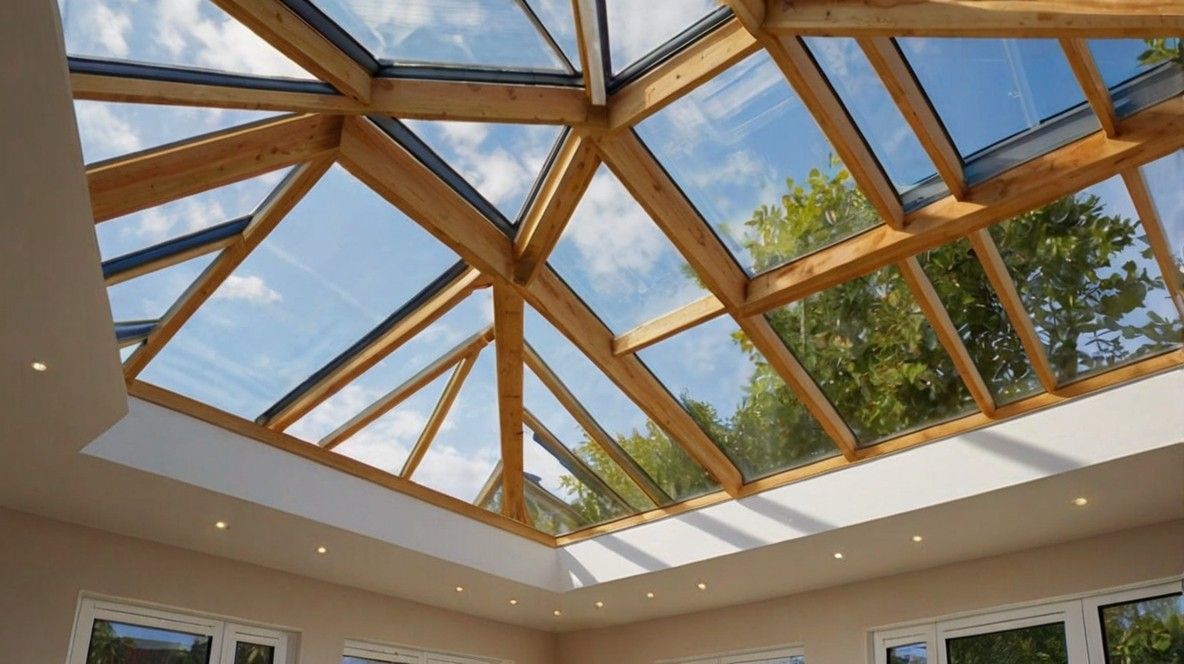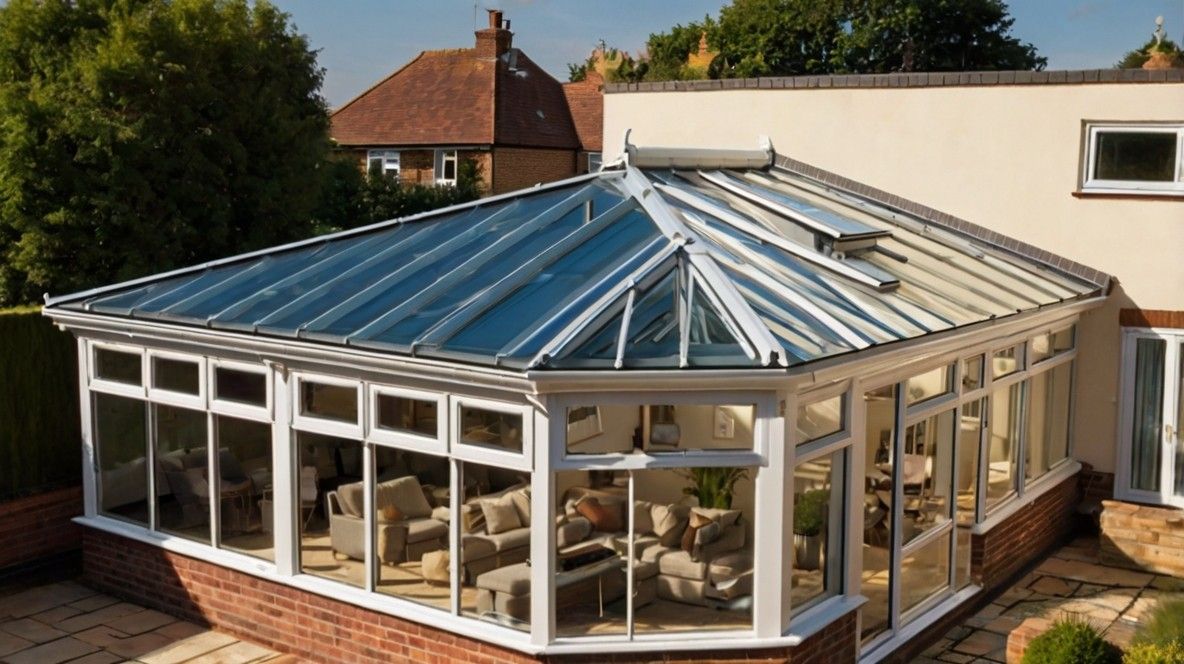Comprehensive Overview of Conservatory Roof Types: Find the Best Option for Your Home
Your conservatory can become your favorite room with the right roof. Modern roofs have changed how we use these spaces year-round. Gone are the days when conservatories were too hot in summer. You won’t need to avoid them during cold winter months anymore. New materials and conservatory roof designs have solved many old problems. This guide will walk you through everything you need to know.
Today’s homeowners can choose from four main conservatory roofs types. These include glass, polycarbonate, solid tiles, and hybrid roofs. Each conservatory roof type offers different benefits and comes with its own price range. Glass roofs bring in natural light, while tiled roofs excel at keeping heat inside. Your perfect choice depends on your budget and how you’ll use the space.
Why should you listen to us?
Over 18 Years in the home improvement industry with expert UK-based support at your fingertips.
Understanding Conservatory Roofs
The right roof can turn your conservatory from a seasonal space into a year-round room. Different materials and conservatory roof designs offer varying levels of insulation, light, and temperature control. Modern roofs have solved many problems that made old conservatories uncomfortable. Your choice will depend on factors like local weather, budget, and how you plan to use the space.
The Basic Structure
Every conservatory roof needs a strong frame to support its weight. Most frames use aluminum or uPVC materials these days. Steel frames work well for bigger conservatories or tiled roofs. The frame holds panels or tiles that keep rain out. Good roofs also have proper drainage systems.
Why Roof Choice Matters
Your roof affects how often you’ll use your conservatory. It controls the room’s temperature throughout the year. The right roof can cut your energy bills by a lot. It also changes how your conservatory looks from inside and outside.
Common Conservatory Roof Types
Each type of conservatory roof has its own strengths and ideal uses. Understanding these differences helps you make the best choice for your home. The four main conservatory roof types include glass, polycarbonate, solid tiles, and hybrid systems. Recent improvements in materials have made each option better than ever before.
Glass Roofs
Today’s glass roofs use advanced technology to control heat and light. According to the Glass and Glazing Federation technical specifications guide, modern glass roofs can reduce heat loss by up to 75% compared to older models. Most glass roofs now have special coatings that reflect away summer heat. The glass panels contain gas between them to improve insulation. Modern glass roofs come with toughened safety glass that won’t break easily.
Many homeowners love glass roofs for their clear views of the sky. These roofs let you watch stars at night. You can see rain falling without hearing much noise. Special glass can even clean itself when it rains.
The latest glass roofs use argon gas between panes for better insulation. This helps keep heating costs down in winter. Tinted glass options reduce glare from strong sunlight. Some conservatory roof types change their tint based on how bright it is outside.
Polycarbonate Roofs
Polycarbonate offers a budget-friendly way to cover your conservatory. These roofs cost less than half the price of glass options. They’re light enough for most existing frames to support them. New polycarbonate roofs come in different thicknesses and colors.
Clear polycarbonate lets in almost as much light as glass. Tinted versions help control heat gain in summer months. Triple-wall panels provide better insulation than older double-wall conservatory roof types. These roofs can last up to 20 years with proper care.
Solid Tiled Roofs
Tiled roofs turn your conservatory into a proper room extension. They use the same tiles as your house roof. This creates a seamless look between your home and conservatory. These roofs keep rooms warm in winter and cool in summer.
Modern tiled roofs include proper insulation layers beneath the tiles. They often have windows or skylights built in. This lets you control how much natural light enters the room. Tiled roofs also reduce outside noise better than other options.
Hybrid Roofs
Hybrid roofs combine the best features of different materials. They might use glass panels alongside solid sections. This gives you control over light and temperature. You can place glass where you want views of the sky. Solid panels go where you need more shade or insulation.
Seasonal Considerations
Weather changes throughout the year affect how comfortable your conservatory feels. A good roof keeps your space useful in both summer heat and winter cold. Different conservatory roof types handle seasonal changes in different ways. Smart choices about materials and conservatory roof designs can solve most weather-related problems.
Summer Performance
Summer heat can make conservatories uncomfortable. Each conservatory roof type handles heat differently. Glass roofs with solar control keep out excess heat. Tiled sections provide natural shade in sunny spots. Ventilation helps remove hot air from the space.
Winter Usage
Winter brings different challenges for conservatory roofs. Good insulation prevents heat from escaping through the roof. Double-glazed glass panels trap warm air between panes. Solid roof sections reduce heat loss even more. Some roofs now include heating elements.
Cost Breakdown
The price of your conservatory roof includes more than just the initial purchase. Installation costs vary depending on your choice of material and conservatory roof designs. Long-term expenses like heating and maintenance also differ between conservatory roof types. Understanding all costs helps you budget properly for your new roof.
Initial Installation
Installation costs vary widely between different conservatory roof types. Basic polycarbonate roofs start around £2,000 for small conservatories. Mid-range glass roofs cost between £3,000 and £5,000 installed. Premium tiled roofs can reach £7,000 or more. Hybrid systems usually fall between £4,500 and £8,000.
Running Costs
Each conservatory roof type affects your energy bills differently. Glass roofs with good insulation keep heating costs down. Solid roofs usually offer the best energy savings. Polycarbonate roofs might need more heating in winter. Better insulation often means lower running costs.
Maintenance Expenses
Regular maintenance keeps your roof working well for years. Glass roofs need cleaning several times each year. Polycarbonate panels may need replacing after 15-20 years. Tiled roofs require checks for loose or damaged tiles. Hybrid roofs combine maintenance needs of different materials.



Over 100 Vetted and Accredited Companies, Reference and Credit Checked.
Installation Process
Installing a conservatory roof requires careful planning and professional skill. With various conservatory roof types available, it’s important to choose the right one for your space. Most installations take between three and seven days to complete properly. The process includes checking your structure, preparing the space, and installing the new roof. Good installation makes a big difference in how well your roof performs.
Planning Permission
Some roof changes need permission from local authorities. Tiled roofs often require planning approval. Height changes might need special permission. Your installer should know local building rules. Always check requirements before starting work.
Structural Requirements
Your conservatory must support your chosen roof’s weight, depending on the conservatory roof types you select. Glass roofs, for example, need strong frames and foundations, while tiled roofs usually require extra support. It’s essential to have an expert check your structure first. Some older conservatories may need upgrades before new roofs are installed, especially when considering the different conservatory roof types available.
Installation Timeline
Most roof installations take between three and five days, depending on the conservatory roof types being installed. Simple polycarbonate replacements might take just two days, while more complex tiled roof installations usually need additional time. Weather can also affect installation schedules, as installers must plan around forecasts to ensure the best conditions for each type of roof.
Long-term Care
Every conservatory roof needs regular maintenance to work its best. Different materials have different care requirements throughout the year. Taking care of small problems early prevents bigger issues later. Regular maintenance helps your roof last longer and perform better.
Regular Maintenance
Every roof needs regular care to last longer. Clean gutters before winter arrives. Check seals around panels or tiles yearly. Look for signs of wear or damage. Fix small problems before they grow bigger.
Common Problems
Different roofs face different challenges over time. Glass seals might leak after several years. Polycarbonate can become scratched or discolored. Tiles might crack or slip out of place. Regular checks help catch problems early.
Professional Services
Some maintenance needs professional help. Glaziers can replace damaged glass panels. Roofers know how to fix loose tiles safely. Specialists understand complex hybrid systems. Keep contact details for trusted professionals handy.
Modern Features
Today’s conservatory roof types include new technologies that improve comfort and efficiency. Smart features can automatically adjust to weather changes. New materials offer better insulation and temperature control than ever before. These advances make modern conservatories more comfortable and efficient.
Smart Technology
New roofs can include smart features. Some glass responds to temperature changes. Automatic vents open when rooms get too warm. Rain sensors close roof windows automatically. These features make conservatories easier to manage.
Energy Efficiency
Modern materials offer better energy performance. Triple glazing keeps more heat inside. Special coatings reflect unwanted solar heat. Improved insulation materials work better than ever. These advances help reduce energy bills.
Heat Control
Modern roofs manage heat better than ever. Research from the Energy Saving Trust energy efficiency report shows properly insulated conservatory roofs can reduce heating costs by up to 25% annually. Special glass reflects away unwanted heat. Solid sections provide better insulation. Good conservatory roof designs prevents heat loss in winter.
Temperature controls help save energy. Smart systems adjust to weather changes. Better insulation means lower heating bills. Cool air stays inside during summer.
Light Management
New roofs balance light and heat well. Tinted sections reduce summer glare. Clear panels maximize natural light. Smart glass changes tint automatically.
Good conservatory roof designs prevents hot spots forming. Light spreads evenly through rooms. Natural light reduces electric lighting needs. Consider the sun position when planning.
Choosing Your Perfect Roof
Making the right choice of conservatory roof types depends on understanding your specific needs and situation. Consider how you will use your conservatory throughout the year. Think about your budget for both purchase and long-term care. Local weather patterns should influence your decision, as certain roof types are better suited to specific climates.
Choosing Contractors
Finding Good Installers
Ask for recommendations from friends. The Federation of Master Builders’ approved contractor directory can help you find qualified installers in your area. Check online reviews carefully. Get at least three detailed quotes. Compare warranties and guarantees.
Good contractors explain things clearly. They show examples of past work. Written quotes list all costs clearly. They answer questions patiently.
Quality Checks
Check installer qualifications carefully. Ask about insurance coverage. Get references from past customers. Visit previous installations if possible.
Good installers belong to trade groups. They follow proper safety rules. Quality contractors offer good warranties. They handle problems quickly.
The Installation Experience
Good installation makes a huge difference in how well your roof performs. Professional installers should check your structure before starting work. The installation process requires careful attention to detail. Most projects finish within a week when properly planned.
Year-Round Benefits
A well-chosen conservatory roof provides benefits in every season. Modern materials help control temperature and light levels effectively. Good conservatory roof designs makes your space comfortable no matter the weather. Your conservatory becomes a true extension of your living space.
Professional Maintenance
Regular professional checks help prevent problems with your conservatory roof types. Experts can spot early signs of wear or damage specific to different roof styles. Professional cleaning keeps your roof looking and working its best, no matter the conservatory roof type. Scheduled maintenance extends the lifespan of your roof significantly, ensuring it stays in top condition.”
Future Trends
Conservatory roof technology keeps improving each year. New materials offer better performance and longer life. Smart features make conservatories easier to manage. These improvements make conservatory roofs more valuable than ever.
Choosing your conservatory roof requires careful thought about several factors. Consider your budget and local climate first. Think about how you’ll use the space throughout the year. Remember that better materials often save money over time.
Take time to research different options thoroughly. Talk with several installers about your needs. Ask to see examples of their previous work. Check reviews from other homeowners. The right roof will make your conservatory enjoyable all year round.
Your conservatory can become a wonderful extra living space. The right roof makes this possible in any weather. Modern materials solve many traditional conservatory problems. With proper planning, you’ll make a choice you’ll be happy with for years.
Over 100 Vetted and Accredited Companies, Reference and Credit Checked.
Frequently Asked Questions
How long does a conservatory roof typically last?
A glass or tiled conservatory roof usually lasts 20-25 years with proper maintenance. Polycarbonate roofs typically last 10-15 years. Regular cleaning and maintenance help extend their lifespan. The quality of installation also affects longevity significantly.
Can I replace my polycarbonate roof with a glass one?
Yes, most polycarbonate roofs can be upgraded to glass. Your installer will need to check if your current frame can support the extra weight. Some structures might need reinforcement before installing glass panels.
Do I need planning permission to change my conservatory roof?
Most roof replacements don’t need planning permission unless you’re changing to a solid roof or significantly altering the height. However, building regulations approval is often required. Always check with your local authority first.
How much does it cost to maintain a conservatory roof?
Annual maintenance costs range from £100-£300, depending on conservatory roof type. This includes professional cleaning, seal checks, and minor repairs. Glass roofs typically cost less to maintain than polycarbonate or tiled options.
Will a new roof make my conservatory warmer in winter?
Modern conservatory roofs significantly improve insulation. A new glass or solid roof can reduce heat loss by up to 75% compared to older polycarbonate roofs. This makes the space much more comfortable during cold months.
How long does it take to replace a conservatory roof?
A typical roof replacement takes 3-5 days for glass or polycarbonate roofs. Solid tiled roofs might take 5-7 days. Weather conditions and conservatory size can affect installation time.
Can a tiled roof be too heavy for my conservatory?
Your conservatory structure needs assessment before installing a tiled roof. Some older conservatories require additional support. A professional surveyor can determine if your structure can handle the extra weight.
Are self-cleaning glass roofs worth the extra cost?
Self-cleaning glass typically costs 20% more but reduces maintenance needs significantly. The coating breaks down dirt and uses rainwater to clean itself. Most owners find it worthwhile for harder-to-reach roofs.
Which Conservatory roof type is best for a south-facing conservatory?
Solar control glass or tinted polycarbonate works best for south-facing conservatories. These materials reflect excess heat while maintaining good light levels. Solid roofs with skylights also provide good temperature control.
How can I tell if my conservatory roof needs replacement?
Watch for signs like leaks, condensation between panels, discoloration, or excessive noise during rain. Increased energy bills and difficulty maintaining comfortable temperatures also indicate your roof might need replacement.
Over 100 Vetted and Accredited Companies, Reference and Credit Checked.
Simply fill in your project details, and Receive competitive quotes tailored to your needs!
With nearly two decades of experience in the industry, we understand the unique challenges and opportunities in the UK home improvements market. When you reach out to us, you’ll be connecting with seasoned professionals who have an in-depth understanding of the UK’s home improvements landscape. Our extensive network of professionals is equipped to handle projects of all sizes. Our knowledgeable, UK-based support team is committed to making your journey smooth, informed, and stress-free.
All our suppliers are members of one or more consumer protection groups below.




